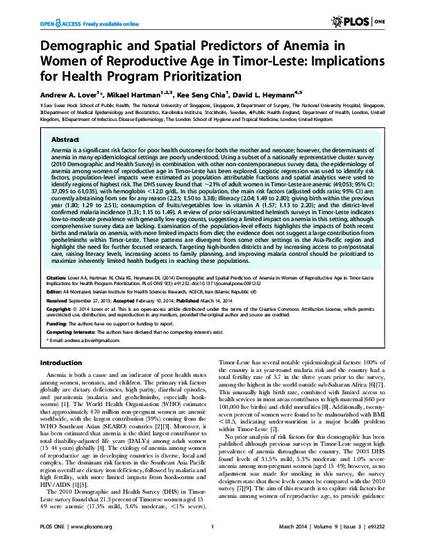
Article
Demographic and Spatial Predictors of Anemia in Women of Reproductive Age in Timor-Leste: Implications for Health Program Prioritization
PLOS One
(2014)
Abstract
Anemia is a significant risk factor for poor health outcomes for both the mother and neonate; however, the determinants of anemia in many epidemiological settings are poorly understood. Using a subset of a nationally representative cluster survey (2010 Demographic and Health Survey) in combination with other non-contemporaneous survey data, the epidemiology of anemia among women of reproductive age in Timor-Leste has been explored. Logistic regression was used to identify risk factors, population-level impacts were estimated as population attributable fractions and spatial analytics were used to identify regions of highest risk. The DHS survey found that ∼21% of adult women in Timor-Leste are anemic (49,053; 95% CI: 37,095 to 61,035), with hemoglobin <12.0 g/dL. In this population, the main risk factors (adjusted odds ratio; 95% CI) are: currently abstaining from sex for any reason (2.25; 1.50 to 3.38); illiteracy (2.04; 1.49 to 2.80); giving birth within the previous year (1.80; 1.29 to 2.51); consumption of fruits/vegetables low in vitamin A (1.57; 1.13 to 2.20); and the district-level confirmed malaria incidence (1.31; 1.15 to 1.49). A review of prior soil-transmitted helminth surveys in Timor-Leste indicates low-to-moderate prevalence with generally low egg counts, suggesting a limited impact on anemia in this setting, although comprehensive survey data are lacking. Examination of the population-level effects highlights the impacts of both recent births and malaria on anemia, with more limited impacts from diet; the evidence does not suggest a large contribution from geohelminths within Timor-Leste. These patterns are divergent from some other settings in the Asia-Pacific region and highlight the need for further focused research. Targeting high-burden districts and by increasing access to pre/postnatal care, raising literacy levels, increasing access to family planning, and improving malaria control should be prioritized to maximize inherently limited health budgets in reaching these populations.
Disciplines
Publication Date
2014
DOI
https://doi.org/10.1371/journal.pone.0091252
Citation Information
Andrew A. Lover, Mikael Hartman, Kee Seng Chia and David L. Heymann. "Demographic and Spatial Predictors of Anemia in Women of Reproductive Age in Timor-Leste: Implications for Health Program Prioritization" PLOS One (2014) Available at: http://works.bepress.com/andrew-lover/8/
Creative Commons license

This work is licensed under a Creative Commons CC_BY International License.
